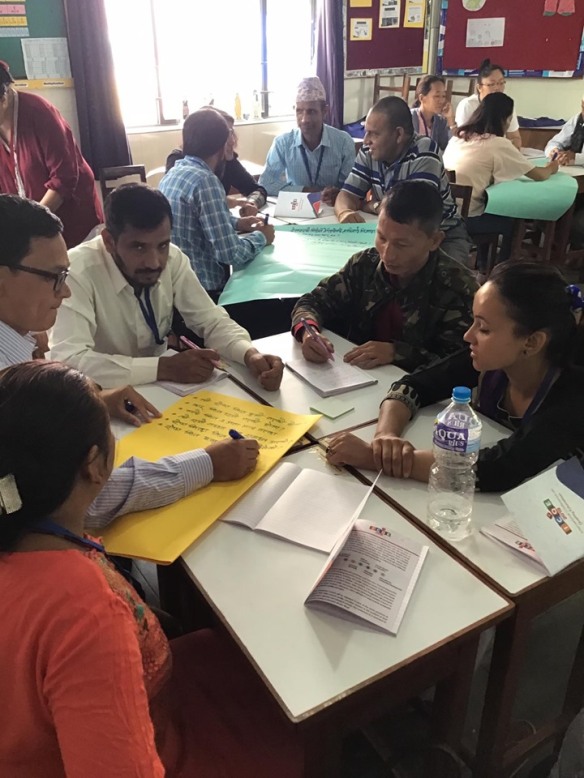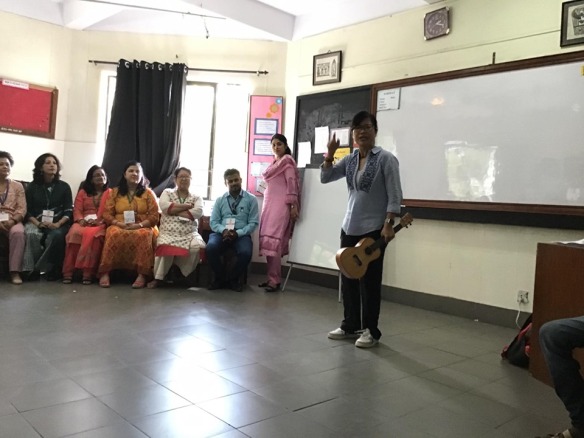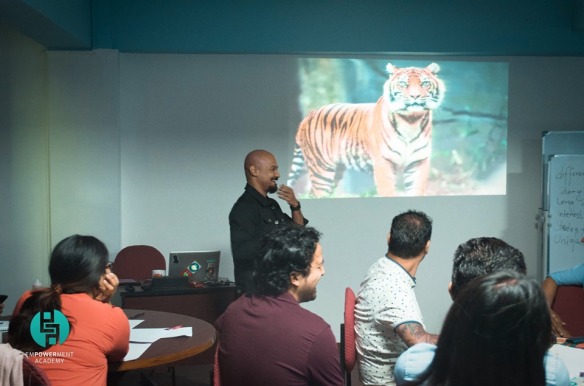
The inaugural session, even though very traditional, had one major highlight for me. The speeches in Nepali. Yes, it was an international conference with participants from several other countries and I saw them putting on headphones for live-translation. Very impressive stuff RBF.
I am not a huge fan of speeches by big people because my heart is among the teachers and in the classroom. Therefore, I had chosen to attend workshop sessions rather than other presentations and keynote speeches.
On the first day, I attended two workshop sessions: Collaboration to Promote Learning, and Storytelling.
Right place, right time:
The first session ended up becoming quite a memorable one. Vani Rana, the facilitator was good. Really good. When I entered the room, I could see that she had pasted three white chart papers on the board, arranged the tables for four participants each, and placed necessary writing materials on the tables. Anticipating a few more participants to walk in, she said, “Let’s wait for a few minutes.” She then asked us to write our names on a paper and draw an image that symbolizes us. Else, we would have taken out our cell phones and played Lolo.

As she began the session, she asked the participants to express their commitment for the session so that everyone a productive time. This was also, I think, well thought of. I have seen many teachers and trainers jump right into the content without making sure that everyone is in the same page. As a result, the participants don’t know what is expected of them, and how they are supposed to behave.
Another interesting thing – she asked us to fill up a form titled “Discussion Partners”. We were to find three participants we didn’t know previously, and fill up their names on the form. They would be our partners for the discussions coming up. This ensured that I had three different partners for three different activities. Loved this idea. I can quickly implement this idea in my class, even when students are unwilling to choose partners beyond their usual circles.
The way she debriefed in between the activities also helped us understand the purpose behind the activities and the theories of collaboration. I went out from her session with several takeaways and facilitation ideas I could implement right away.
Wrong place, wrong time:
The second session was on Storytelling and I thought I was in the wrong place through out the session. For some reason, I could not stay focused on the activities. I suppose I made an error in choosing the session as the stuffs turned out to be too elementary for me and I lost my interest right away. The other participants, mostly school teachers from different parts of the country seemed quite engaged and enjoying it though. So, I don’t want to take away any credit from the two facilitators.
In the moment, my mind was full of questions. What if the participants of our own workshop sessions felt the same? What if they felt bored and out of place? What would I do? What would I feel? Is it possible to engage everyone all the time?
Embracing Ambiguity:
And, it was my turn. My session on “Helping Students Embrace Questions rather than Answers” was scheduled for 10.00 AM to 11.30 on Day 2 of the conference. I had designed the session based on the Question Formulation Technique (QFT) initiated by the Right Question Institute.

I had done a session on this theme once in different teacher training program and it hadn’t gone that well. Primarily because I was not able to communicate enough the purpose of QFT. So, this time I was a bit cautious about how I might go about it.
Another challenge: I didn’t have any details of the participants – number, background, and expectations. However, assessing the workshops I had attended on Day 1, I could imagine they would generally be teachers from pubic schools and from outside the valley. Essentially, I was going to shoot arrows in the dark.
So, reached the room 30 minutes early. Checked the name list of the participants. Apparently 26 had signed in. Went in and started arranging the desks. A few volunteers came for help (Thank you). Udgum (Educational Designer, EA) also lent his hands to set up the projector and the sound. All set and checked, we went outside to meet others.
9.55 AM. I walk in and see the room full of people. Didn’t expect that. Had to arrange tables for 8 more people. 90 minutes later, as I was packing my stuffs in, I felt the arrows somehow landed on the target.
(Oh by the way, we also had a poster presentation on teachLAB, during the conference. Udgum was supposed to stand by it for 8 hours each day, and explain the poster to the participants rushing by. I’m sure no one saw him do that though.)
Creativity in Consistency:
After I took off my facilitator’s hat, I went in to attend two more workshop sessions. One was on Metacognition and Comprehension Strategies by Richa Singh, Rato Bangala School. For the past 2 years, I had been reading about metacognitive activities and implementing the insights from Coursera’s “Learning how to Learn” course. (And also the bible on metacognitive activities: Make it Stick – The Science of Successful Learning.) I was glad to know that teachers at RBS were implementing this concept in their teaching and learning.
The next session was titled “Encouraging Creativity through Music & Movement” and this blew my mind. When I entered the session, I saw there were already over 30 participants sitting around in a circle and the facilitator Ms. Lavina Chong was ready with a ukulele in her hands. After a short introduction (she is a Singaporean educator with 19 years under her belt), she started teaching us a song and asked us to incorporate our hand gestures and tapping. And progressively, she demonstrated several variations on how we could incorporate body and movement in a single song. While she was at it, in her typical Chinese/Singaporean accent, she tried a Nepali version of the same song and that seemed to create a bond among the participants. In the 90 minute session, everyone jumped, danced, moved around, and played with cups and ropes.

Through out the session, I felt like I was back in the kindergarten and wished I had a teacher like that. I had several flashbacks of my school days which are just a series of blur moments, nothing memorable.
So, what made this session so awesome? I believe a) the facilitator Ms. Lavina, b) the ukulele, c) her jokes, and d) the participants – all adults who were giggling, laughing, playing, dancing like kids.
Then a question hit my mind. Was she doing anything revolutionary? Nothing like it. So what made her so good, so special? Two things, I believe. Passion and consistency. And through those two emerged her unique creative take on using music and movement to teach kids and train teachers.
And to wrap up:
From the three sessions I participated and one that I conducted, I strongly feel that teachers need to come together more often. Beyond conferences, seminars, and workshops . There is so much to share and so much to learn from each other. Not just for the methods, classroom tips, and not just for the handouts, we need to meet and tell empowering stories to each other. Care each other. Respect each other. In our society, where teachers get blamed for almost every wrongs in the education system, we need to look out for each other.
Gratitude to Rato Bangala Foundation for selecting our proposals of workshop and poster presentation.





